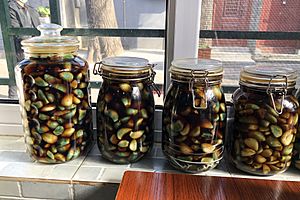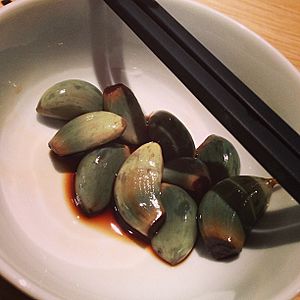Laba garlic facts for kids
The Laba garlic is a special kind of garlic. People make it by soaking garlic in vinegar. It turns a beautiful green or blue-green color. It tastes sour and a little spicy. This garlic gets its name because it's usually made on the 8th day of the 12th month of the Chinese Lunar calendar. This day is known as the Laba Festival. Any green, vinegary garlic is often called Laba garlic.
Laba vinegar is simply the vinegar used to make Laba garlic. Making Laba garlic is a popular tradition in northern China. People often eat Laba garlic and its vinegar with dumplings. This is a traditional food for the Spring Festival in China. Laba garlic can also be served as a dish on its own during the Chinese New Year.
Culture and History
The exact history of Laba garlic is not fully known. One popular story explains its name. In Chinese, the word for "garlic" sounds like the word for "count."
Long ago, business owners would count their money and debts on the eighth day of the twelfth lunar month. This day was close to the Chinese Spring Festival. So, it was a good time for people to collect money owed to them. Giving someone vinegar-pickled garlic was a polite way to remind them about a debt.
How to Prepare Laba Garlic
Making Laba garlic is quite simple.
- First, get a clean container.
- Peel the garlic cloves and wash them.
- Put the garlic and vinegar into the container.
- Seal the container tightly.
- You can add sugar or salt if you like.
- Place the container in a cool place.
- It usually takes about 20 days for the garlic to turn green.
In some areas, people use specific purple garlic and rice vinegar. They make it exactly on the eighth day of the twelfth lunar month. This is seen as the "traditional" way.
Why Laba Garlic Turns Green
Have you ever wondered why Laba garlic changes color? It's a natural chemical reaction! Garlic has many special compounds that contain sulfur. These compounds are usually kept separate from an enzyme inside the garlic.
When you soak garlic in vinegar, the acid in the vinegar damages the garlic cells. This allows the enzyme to mix with the sulfur compounds. When they mix, they create new colorful compounds. These new compounds absorb light, which makes the garlic look green or blue-green.
The exact color depends on how many of these new compounds are formed. Don't worry, these colorful pigments are completely safe to eat!
See also
 In Spanish: Ajo laba para niños
In Spanish: Ajo laba para niños



